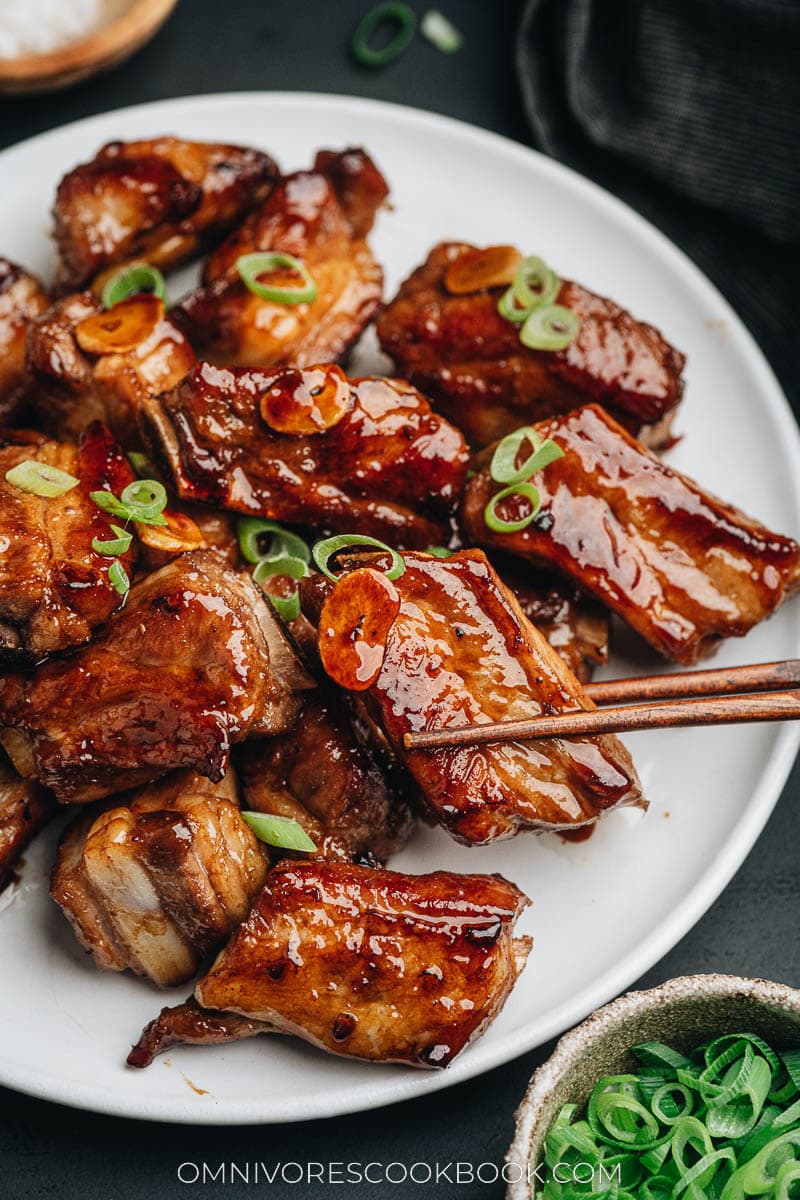
What is sweet and sour ribs
Sweet and sour ribs (糖醋小排, tang cu xiao pai) is a famous dish from Shanghai cuisine. The small pork ribs are fried until golden crispy, then coated with a thin layer of sticky sweet and sour sauce. The ribs have a special chewy texture and a crunchy caramelized surface, and they’re bursting with flavor. The dish can be served hot or cold, usually in small quantities as an appetizer.
Why this recipe
There are a few different approaches to recreating this dish at home. For example, the traditional way is to marinate, deep fry, and then cook the ribs with the sauce. However, I found the approach below is slightly easier and yields a great result:
- Blanch the ribs with aromatics to get rid of any gamey taste, and quickly cook through the interior.
- Brown the ribs using the melted sugar method (more details below) for the caramelized texture.
- Stir the ribs with the sauce to finish up.
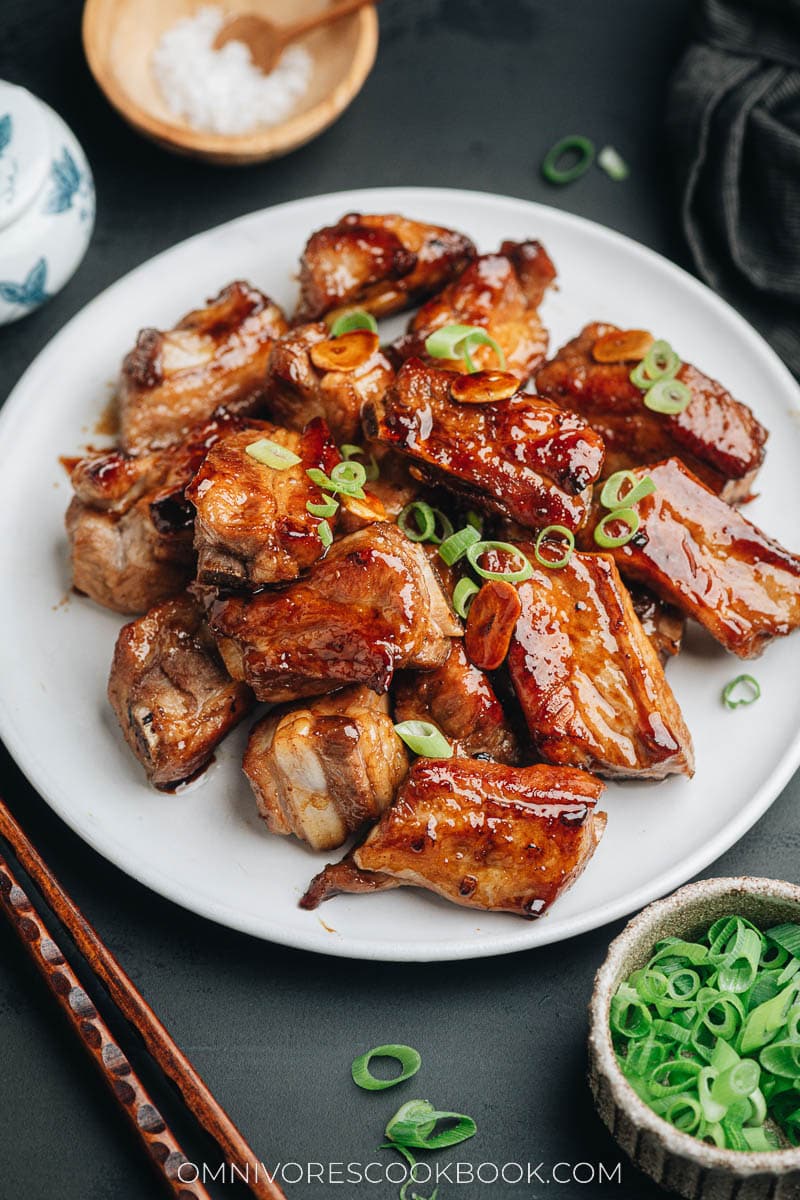
Ingredients for sweet and sour ribs
This sweet and sour ribs recipe requires a few very simple ingredients.
What type of pork ribs to use
The most important thing for sweet and sour ribs is to use the correct type of pork ribs. To mimic the authentic restaurant dish, you should use 2” (5 cm) long small single riblets. Spare ribs work better than baby back ribs because they have a thinner layer of meat. The thin layer will cook better in this recipe because the meat will cook through more quickly and yield a better texture given the short cooking time.
You can usually find this type of ribs at Asian markets, especially Chinese and Korean markets (like H Mart). They are often sold in fully cut-up form in a package. Either that, or a slab of partial ribs that is cut crosswise. These days, you can even shop for them online and get them delivered using online Asian grocery stores such as Umamicart.
If you do not have access to an Asian market, it’s possible to buy a slab of regular spare ribs. And you could ask the butcher to slice the ribs crosswise using their saw. Then you only need to cut them into single riblets at home, which is quite easy to do with your regular knife.
It is also possible to use whole riblets without cutting them short. In this case, try to find a smaller slab with flat ribs, which will be easier to brown.
The sauce
The sweet and sour sauce is made of three simple ingredients:
Mise en place
Once you’re ready to cook, your table should have:
- Aromatics for braising (green onion, ginger, star anise, dried chili pepper)
- Shaoxing wine
- Pork ribs
- Measured out oil (it’s important to measure the oil in this recipe)
- Mixed sauce
- Sliced garlic
- Sugar
- Sliced green onion for garnish
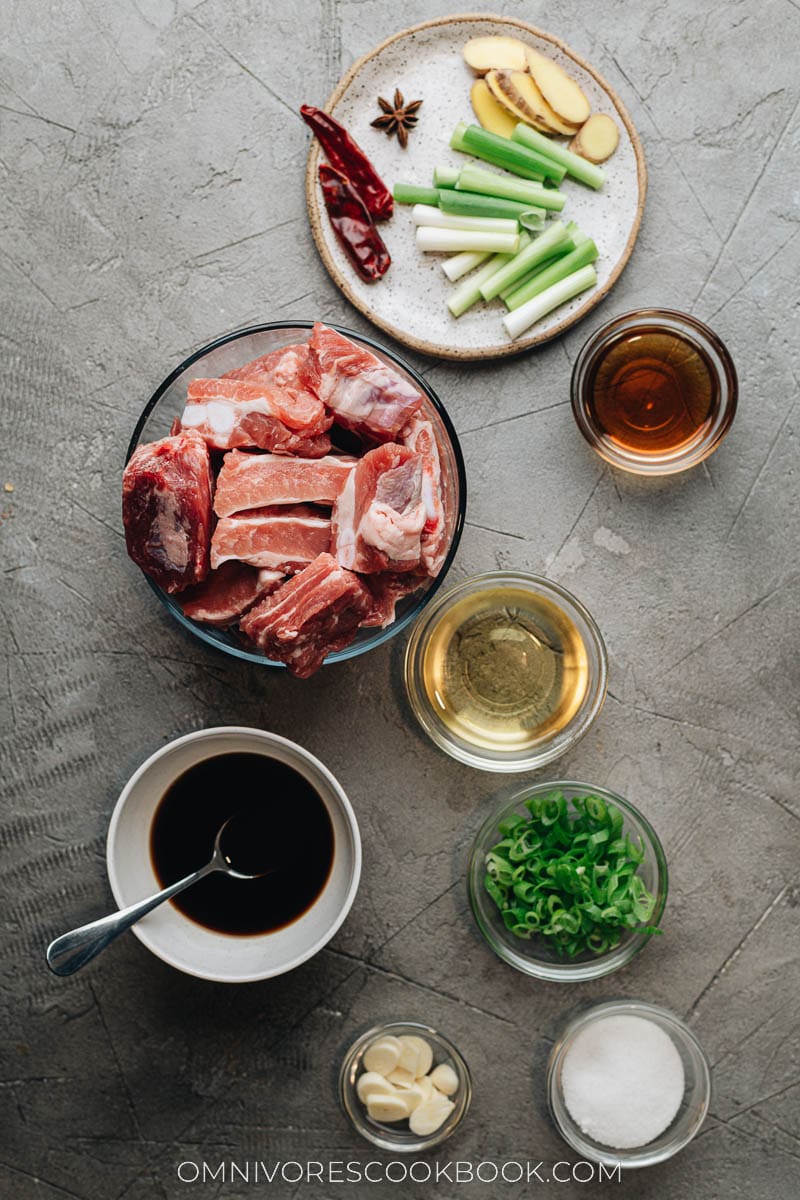
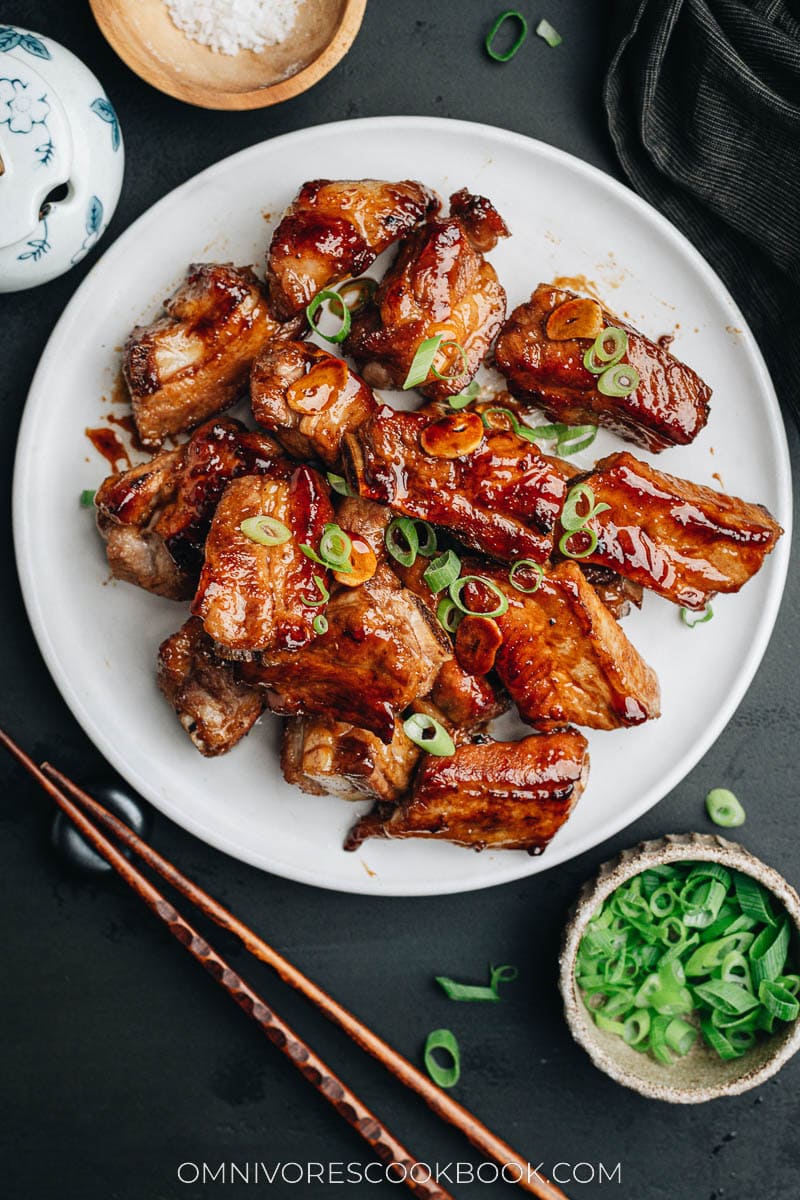
How to cook sweet and sour ribs
The melted sugar browning method
炒糖色 (chao tang shai), or browning meat in melted sugar, is a cooking technique that is widely used in Chinese stir fries and braised dishes, to create a special texture to the surface. Different from browning the meat directly in hot oil, the melted sugar adds a beautiful golden color to the meat, and creates a light caramelized and crispy texture, along with a slightly sweet taste. For example, the popular red braised pork uses this method to brown the meat before braising.
You start by adding sugar to cold oil. Cook it slowly until the sugar melts and turns golden. It’s important to get a proper oil temperature without burning the sugar. Then the pork is then added for a quick stir fry. You will find that the pork gets a nice beautiful reddish golden color in a minute or so, along with the caramelization of the sugar.
What pan to use
In Chinese restaurants it’s common practice to use a wok to melt the sugar. Because of the round shaped wok bottom, the sugar will be submerged in the oil and melt more evenly.
In a US home kitchen, I found a nonstick pan works better. Because:
- If you do have a wok, it’s very likely that it’s a flat-bottomed wok. In that case, it doesn’t help with the melted sugar process that much (I’ve tested it)
- If you use a carbon steel or cast iron wok, the surface will react with the vinegar in the sauce, which will cause the wok seasoning to fade.
When using a nonstick pan, the biggest challenge is to disperse the oil and sugar as evenly as possible, so the sugar is in contact with as much oil as possible. But I found the result with a nonstick pan to be quite nice, without the worry of un-seasoning my wok.
Sweet and sour ribs cooking process
- Blanch the ribs with aromatics
- Skim the brown foam, then drain the ribs
- Heat up sugar in oil
- Melt the sugar slowly, until it turns golden
- Add the ribs and quickly turn over several times to coat each side with the melted sugar, then transfer to a plate
- Saute the garlic with a bit of oil
- Add and reduce the sauce
- Mix everything together
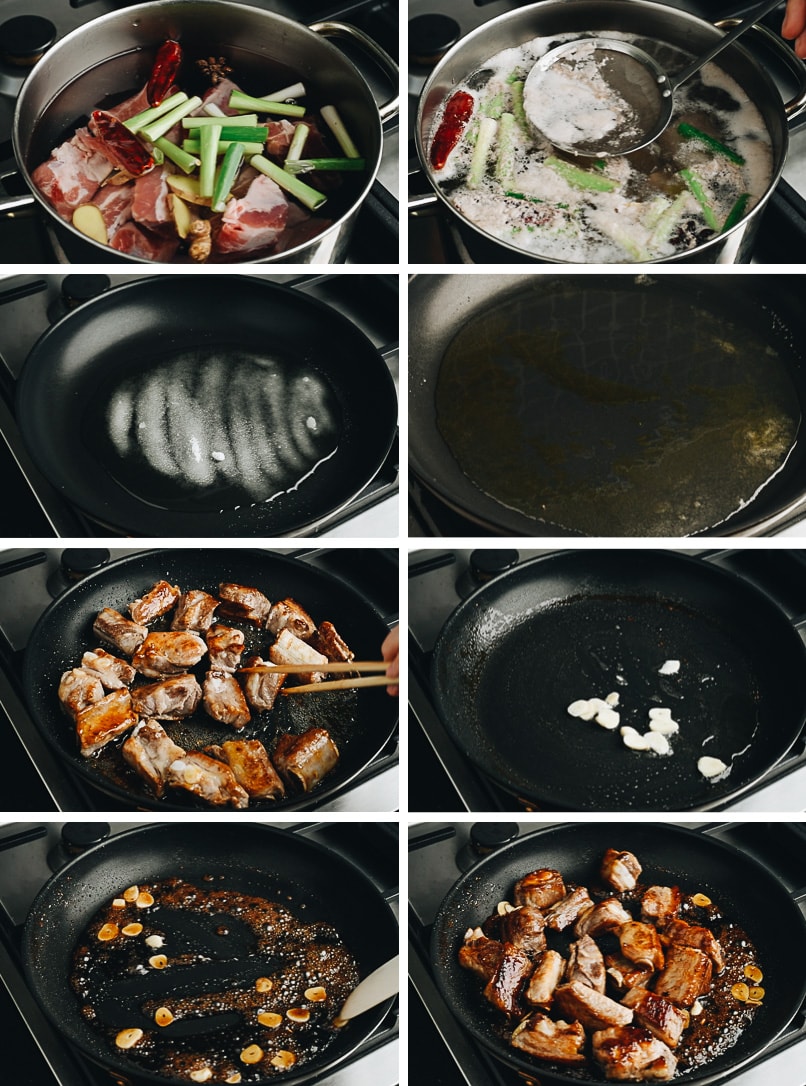
NOTE
You might find that I use a lot of oil in the recipe, which facilitates the sugar melting process. But don’t worry, the ribs won’t absorb all this oil during the cooking and you will discard most of the oil in the end. It is very important that you remove the excess oil after browning the ribs and before adding the sauce. If there’s too much oil in the pan, the sauce won’t thicken properly.
Afterthoughts
The melted sugar technique is not the easiest thing to master, and even many Chinese home cooks do not feel confident they’ll get a good result every time. So I wouldn’t recommend this recipe if this is the first Chinese stir fry you make at home. But if you have some Chinese cooking experience under your belt and follow my instructions closely, it will give you a very pleasant result, if not a perfect one. This dish is quite a fun challenge and you will get a result that is close to restaurant quality sweet and sour ribs.
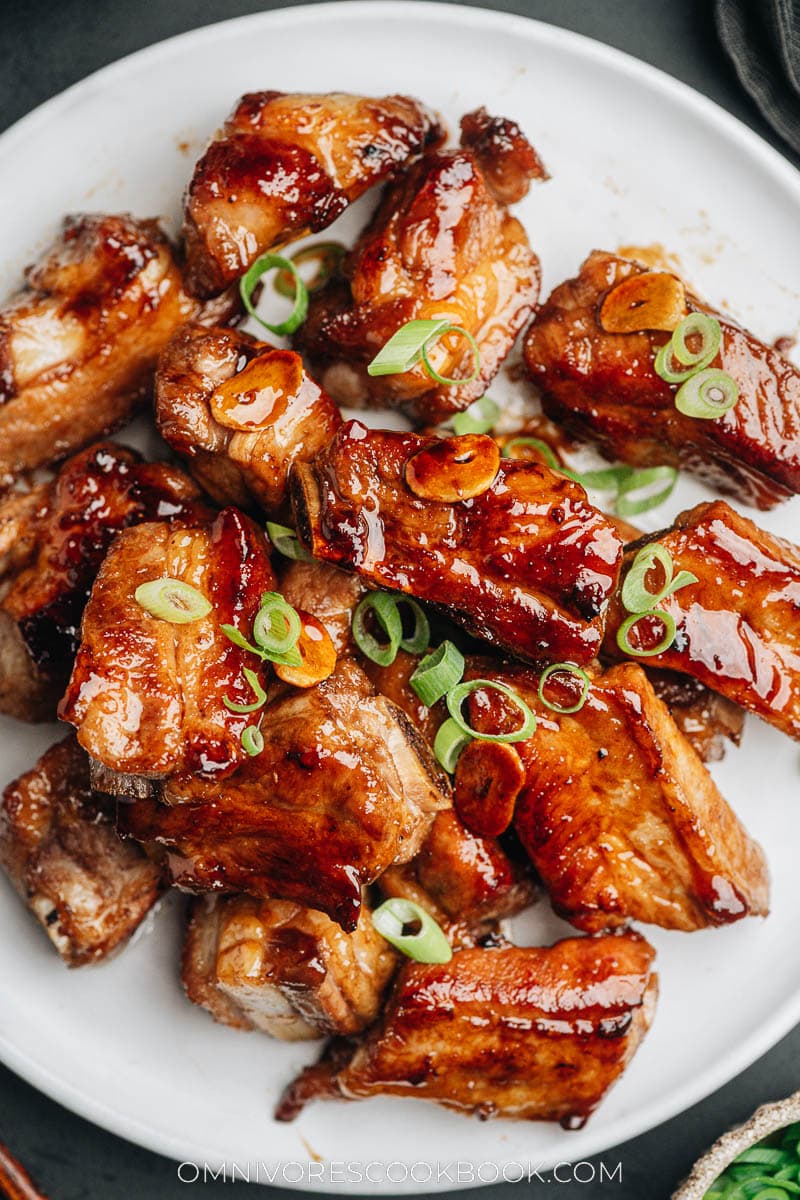
Other delicious Shanghai dishes
- Rice Cake Stir Fry (炒年糕, Chao Nian Gao)
- Yang Zhou Fried Rice (扬州炒饭)
- Air Fryer Garlic Ribs (蒜香排骨)
- Sister Song’s Soup (宋嫂鱼羹, Chinese Fish Soup)
- Braised Chestnut Chicken (板栗炖鸡)
- Sheng Jian Bao (生煎包, Shanghai Pan-Fried Pork Buns)
Chinese Cooking Made Easy
Are you new to this website? This free email series is a great place to start. I’ll walk you through a few of my most popular recipes and show you how and why they work. You’ll quickly start to cook better Chinese food in your own kitchen.
Watch video
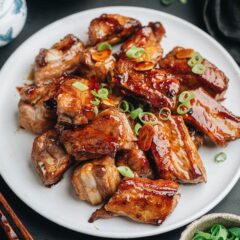
Sweet and Sour Ribs (糖醋小排)
Ingredients
For boiling ribs
- 1.5 lb (750 g) pork spare ribs , trimmed to 2” (5 cm) in length, cut into one-bone sections (*footnote 1)
- 2 tablespoons Shaoxing wine
- 1 thumb-size ginger , sliced
- 5 to 6 green onion white part , green part sliced for garnish
- 1 whole star anise
- 2 dried chili pepper
For the stir-fry
- 2 tablespoons Chinkiang vinegar
- 1 tablespoon light soy sauce (or soy sauce)
- 4 tablespoons peanut oil (or vegetable oil)
- 3 tablespoons sugar , separated
- 2 cloves garlic , sliced
Instructions
- Add the pork ribs to a large pot. Add cold tap water to cover the ribs. Add the Shaoxing wine, ginger, green onion, star anise and chili pepper to the pot. Cover and cook over medium-high heat until brought to a boil. Uncover and continue to cook for 5 minutes. Use a ladle to skim the foam from the surface and discard it. Once done, transfer the ribs to a colander to drain. You can strain and save the broth, so you can use it to make a soup later (*see footnote 2).
- Mix the black vinegar, light soy sauce and 1 tablespoon of the sugar in a small bowl, set aside.
- Add the peanut oil to a large nonstick skillet, then carefully sprinkle the remaining 2 tablespoons of the sugar so it spreads out into a thin layer in full contact with the oil. Cook over medium heat. Swirl the pan occasionally to help the sugar keep contact with the oil, to help with even dissolving. If the sugar has trouble distributing evenly, it’s OK to use a spatula to spread it. But you shouldn’t stir the sugar too much, which will cause crystallization. Observe the sugar carefully when the color starts to turn pale yellow. You might need to lower the heat if a portion of the sugar is turning color too fast and the rest of the sugar has not dissolved yet. When most of the sugar turns golden, carefully add the ribs to the wok. Stir constantly to coat the ribs well with melted sugar. Stir until the ribs turn golden brown, then turn off the heat.
- Transfer all the ribs to a plate and set aside. Pour the oil into a bowl and wipe the pan clean with paper towels.
- Add back 2 teaspoons of the oil and turn the stove back to medium-high heat. Add the garlic. Stir a few times to release the fragrance.
- Pour in the vinegar mixture. Cook and stir until the sauce has reduced by half and become thicker. Add the ribs back and continue stirring to coat the ribs evenly. Transfer everything to a plate and garnish the ribs with chopped green onion. Serve hot or at room temperature as an appetizer or main dish.
Notes
- You will find this type of ribs at most Asian markets. If you shop at a regular grocery store, ask the butcher to chop the ribs into smaller pieces when buying. Try to select a thin and small rack of ribs, because a thick cut won’t absorb the flavor well and the meat will be too tough in a stir-fry.
- The broth will be quite flavorful and you can use it as a soup base, for example, to cook a winter melon meatball soup.
Nutrition

Did you make this recipe?
I’d love to hear how it turned out for you! Please take a moment to leave a 5-star rating ⭐️ and share your thoughts in the comments further down the page. It really helps others discover the recipe too.

Mike
Hi Maggie, are what you refer to as “riblets” the same as “baby back ribs”? I’m in Australia and we don’t necessarily get the same rib cuts (or perhaps we just call them different names) so just trying to work out exactly what sort of ribs I should look for.
Maggie Zhu
I’m not 100% sure either because the package doesn’t usually contain this information, but I think they are baby back ribs due to the look. On the other hand, I do think it’s totally use other part of ribs. They will have slightly different lean fat ratio and the thickness of the meat is different, but they should still work for this recipe.
BobB
Twice now …5 stars in my dining room! Thanks!
BobB
Maggie Zhu
So happy to hear you like this one and thanks for leaving a positive review 🙂
JUN
Is the meat soft to bite after 5 min cooking?
Maggie Zhu
The meat will be a bit chewy but soft enough to bite. The key of this recipe is to cook the pork just until it’s done, and not over cooking it, so it nice a nice texture. It will turn tough if you cook it for longer (then they turn soft again after another hour of cooking or so).
Lita
Amazing, my husband and kids love it. easy to make and want u to make and eat more
Brad
Nothing like the sweet and sour ribs I have been eating for the last 50 years. I have searched in vain for an authentic recipe. My last hope is to find a cookbook published in the 40’s or 50’s everyone seems to feel we can’t cook like the restaurant but I beg to differ. I would be grateful to find a true sweet and sour ribs recipe.
derek
Hello Maggie>>>CONGRATULATIONS on your 9th year presenting your wonderful recipes, of which I have prepared and cooked many over the years. I am using this review site to tell you that.
All the best in continuing to bring the wonders of Chinese food types to the masses.
ds-Canada
DR HANSON
GREAT RECIPE!!!!
Al S.
I am a huge fan of your recipes. People think I am an expert at cooking chinese food, thanks to you. I have dietary restrictions ( I try to adhere to kashruth (Kosher) laws so I have had to adapt a little. Since pork is forbidden, what meat might be successful in this recipe?
Maggie Zhu
I think chicken is a great replacement. Beef works with the flavor here, but you need to be very careful not to over cook it, otherwise the meat will turn tough.
For chicken, the cooking change a bit depends on the cuts you use. If you use larger bone-in cuts like thigh or drumsticks, you can follow the same steps (blanch then mix with the sauce). If you use smaller cuts such as bite-size boneless thigh or breast, I would simply brown the chicken in a lightly oiled pan instead of blanching.
Nany
I made this and it’s amazing. Took me some time to get the caramel but eventually it all came together beautifully. Great flavor. Thank you for sharing.
Carolyn Russell
This recipe is a keeper. I made it for a family dinner last night and everyone raved about how good the ribs were. Thank you for the clear directions.
Kelly – Life Made Sweeter
These pork ribs look absolutely mouthwatering, Maggie! Love the flavors and the pictures are stunning!
Regina
This recipe looks delicious, and your ‘how to-do’ it is so good it makes me feel I should try and make it. Thank you.
Nagi@RecipeTin Eats
Oooh. My mouth literally watered at the sight of these glossy glossy ribs….Maggie, these are stunning! I have a question though. In Australia, pork ribs are typically thought of as a cut that must be slow cooked otherwise it is tough. What is different with this recipe? The only difference I can see from the image is that the pork ribs are cut much smaller than the American style ribs we get here. Thanks Maggie!
Maggie
Pork ribs are popular here and we have a few ways to cook them, like boiled, steamed, stir fired, braised or fried. For this recipe, the ribs are cooked very briefly, before they turned chewy. The cooked ribs will be springy, but not chewy. For this recipe, you need to pick a thinner cut of ribs (younger pig, and choose the part that is close to the belly), and chop them to bite size. So the pork meat is actually quite thin, like the normal sliced that is used in stir fried dish, only with bones. It’ll be difficult to cook this dish properly if you can’t find the right cut. Btw, this one will be on me if you ever visit Beijing! 😉
Sue
There are two types of pork ribs sold in US supermarkets. Look for Baby (back) pork ribs. It is very easy to cut between bones (not cross bones) by yourself. From the picture, you can see the size of each piece. You don’t need meat cleaver to do the job because you only cut the meat (between bones), not bones.
Michelle @ Vitamin Sunshine
The caramelization is beautiful! Great detailed description on how to do it.
Shelby @ Go Eat and Repeat
I have been searching for a recipe like this but have had the hardest time finding one. I love this dish and I’m sure your recipe for it is fantastic!
Maggie
Hi Shelby, thanks for stopping by and I’m so glad you like this one! Have a great day 🙂
mira
I love the valuable information and suggestions you include in every recipe Maggie! These ribs look so delicious!!! Pinned!
Bam’s Kitchen
Your Chinese ribs look finger licking good. I think your boiling the ribs first was a great idea to help tenderize the ribs. I love the brown glaze from the sugar stirfry. Gorgeous dish! Pinned!